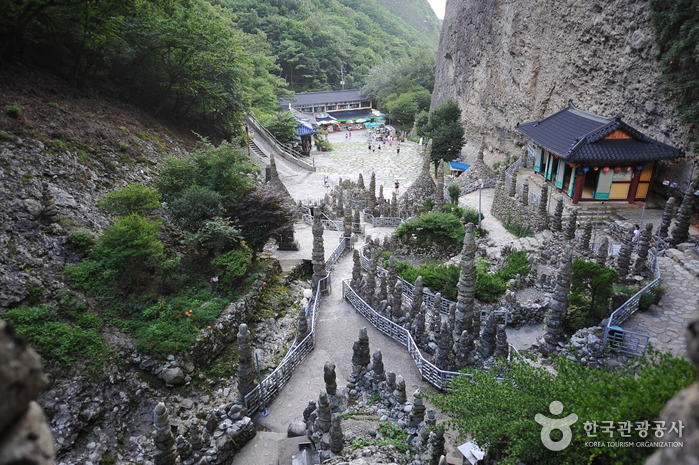Getting to Tapsa Temple
If you’re traveling from Seoul, the easiest way to reach Tapsa Temple is by taking an express bus from Central City Bus Terminal to Jinan. From Jinan Bus Terminal, you can then hop on a bus bound for Maisan. The temple is located 1.9km away from the southern parking lot of Maisan Mountain in Dongchon-ri, Maryeong-myeon, Jinan-gun, Jeollanam-do.
Exploring Tapsa Temple
As you arrive at Tapsa Temple, you will immediately be captivated by the sight of over 80 stone pagodas spread throughout the area. These unique pagodas were built by Lee Gapyong, a retired scholar, in the late 1800s. Each pagoda has its own distinct shape and size, ranging from cone-shaped to straight-shaped. The most impressive among them is the Cheonjitap tower, located behind Daeungjeon. This tower stands at an incredible height, measuring 3 times taller than an average adult!
The Mysterious Tower
What makes Tapsa Temple even more fascinating is the mystery surrounding the construction of these stone pagodas. It is said that Lee Gapyong single-handedly collected stones during the daytime and built the pagodas at night. Despite being standing for over 100 years, these pagodas have never collapsed or even moved during strong winds, leaving many in awe of their stability. The craftsmanship and precision behind their construction remain a topic of great intrigue.
Cherry Blossom Paradise
If you happen to visit Tapsa Temple in the spring, you’re in for a breathtaking treat. The temple is renowned for its cherry blossoms, which cover an area of 1.9km from the southern parking lot of Maisan Mountain to the entrance. This picturesque road is not only a sight to behold but also serves as the venue for the Maisan Cherry Blossom Festival. The delicate pink petals create a magical atmosphere, making it a must-visit destination during the blooming season.
The Tower Ensemble
Among the stone pagodas at Tapsa Temple, the Cheonjitap towers hold special significance. Comprised of two twin pagodas placed in the south and north directions, the Cheonjitap is the main pagoda that adds a sense of balance to the entire temple complex. Originally, there were 120 towers, but today, only 80 remain. The two towers at the forefront are named Ilgwangtap and Wolgwangtap. These pagodas have withstood the test of time, including typhoon winds, which is truly remarkable. Additionally, if you observe closely, you’ll notice that the towers are slightly tilted in both directions, indicating that Lee Gapyong took the wind direction into account during their construction.
Visiting Tapsa Temple is like stepping into a world of ancient mystique and natural beauty. From the historical stone pagodas to the enchanting cherry blossoms, this destination offers a unique and unforgettable experience. Make sure to plan your trip accordingly and immerse yourself in the rich history and stunning scenery that Tapsa Temple has to offer.

